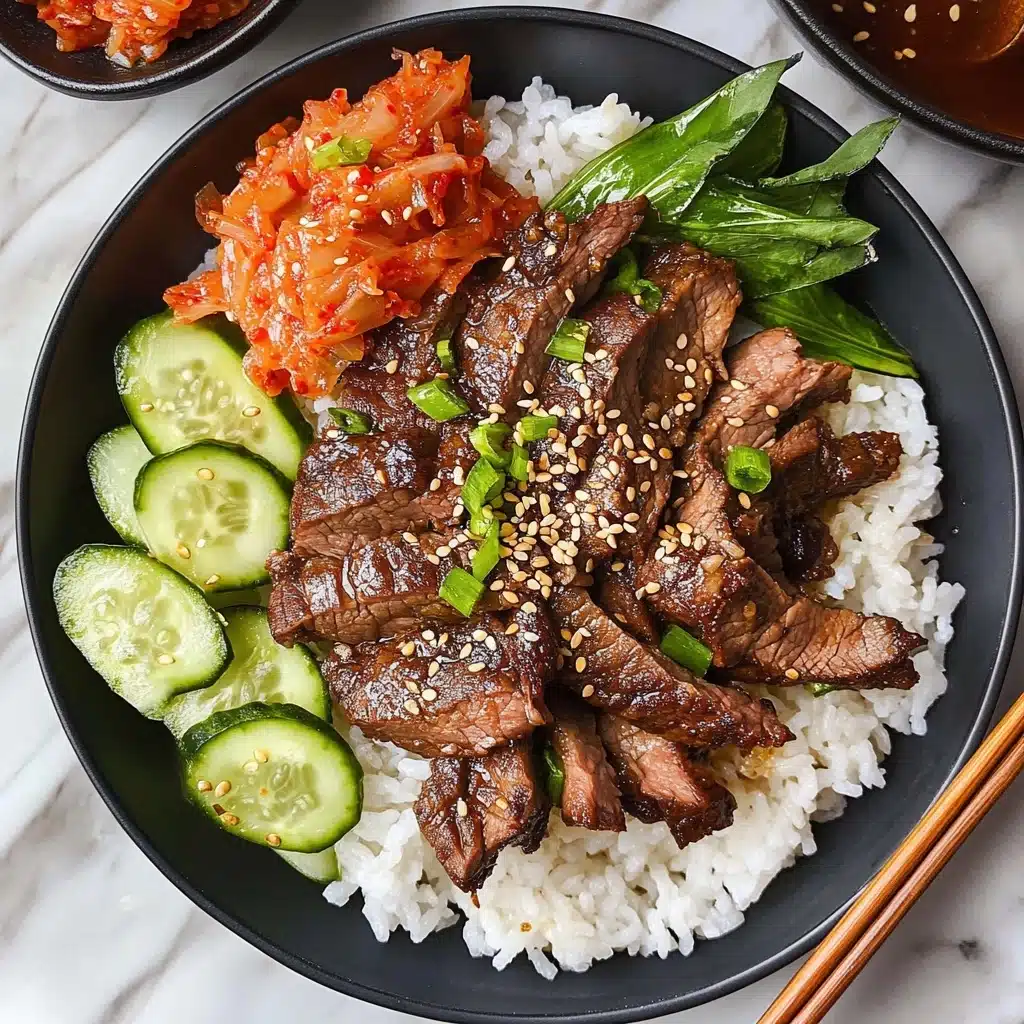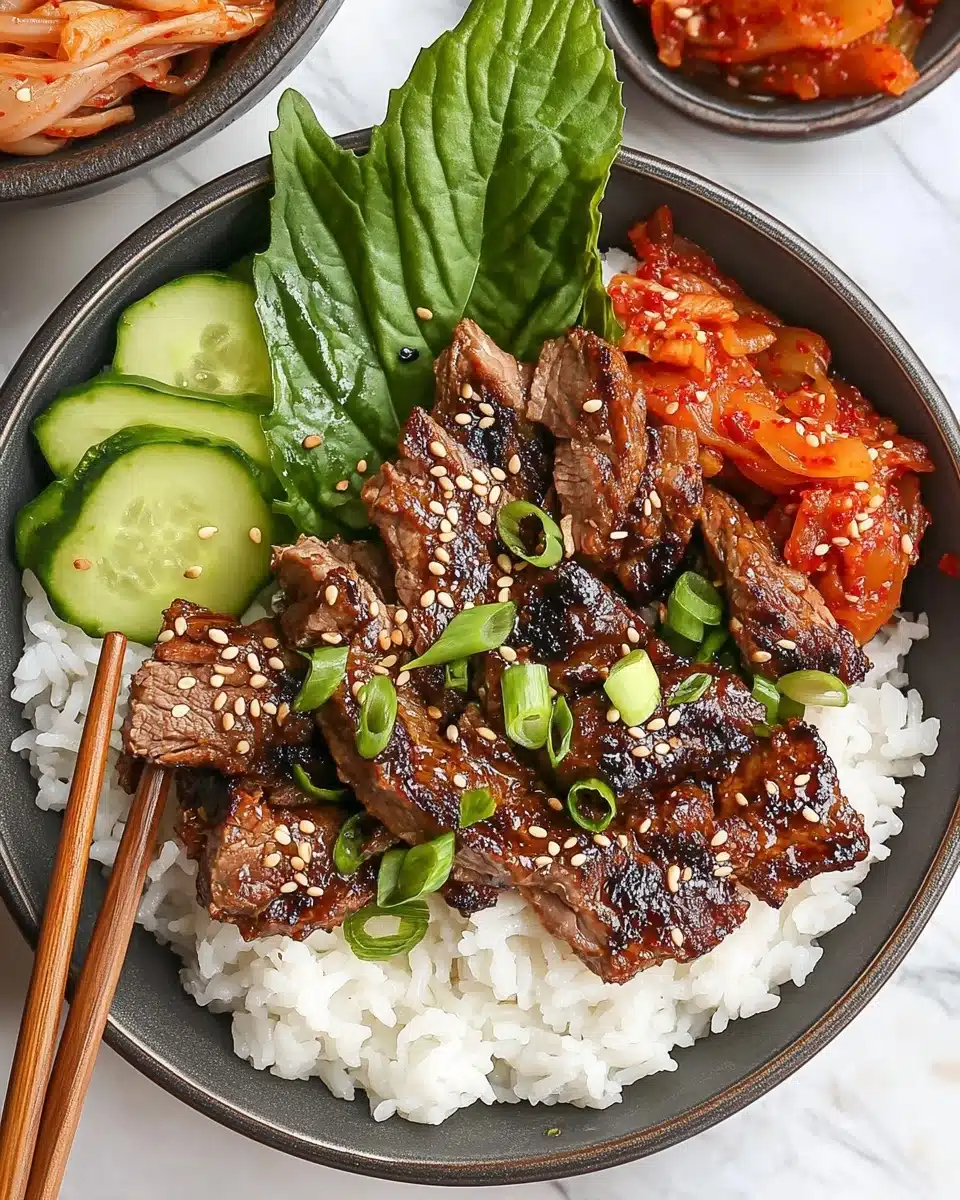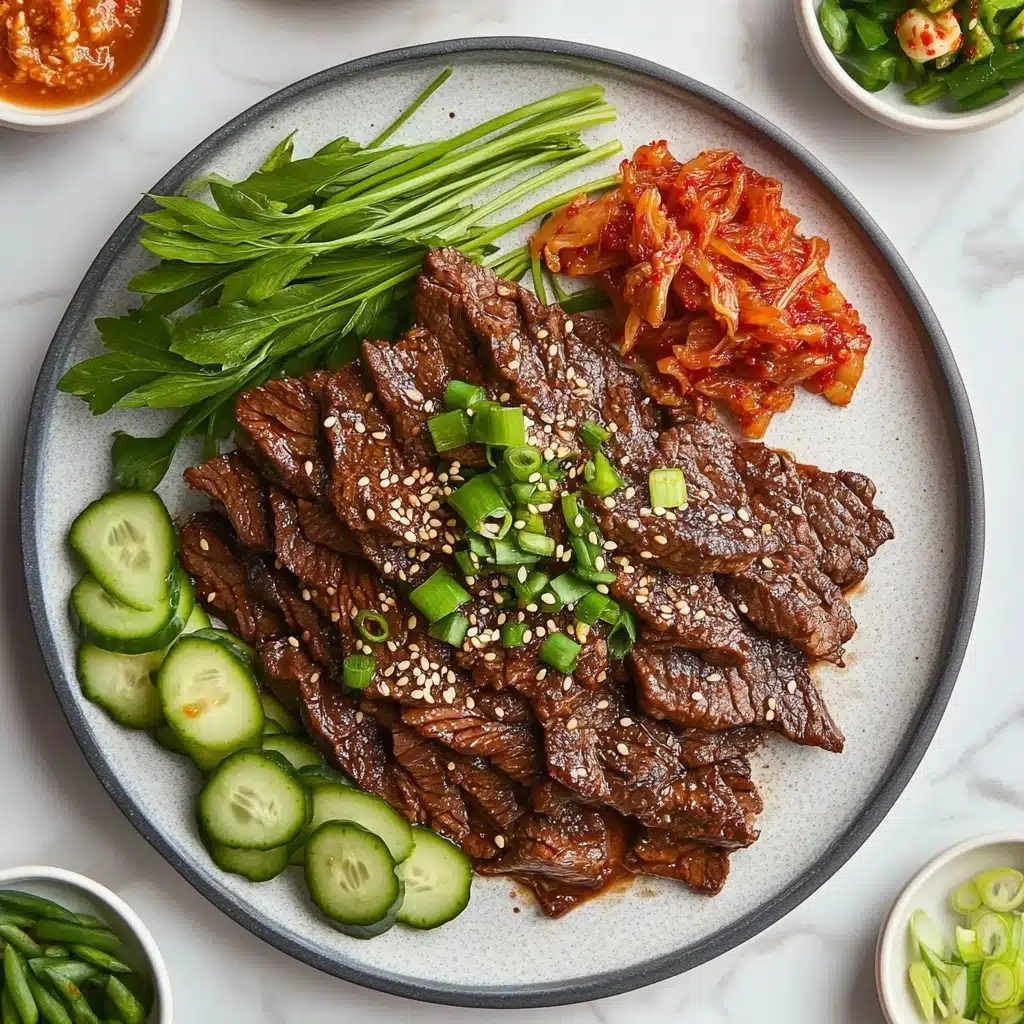When it comes to Korean cuisine, few dishes are as beloved and iconic as **Korean Beef Bulgogi**. This mouthwatering marinated beef dish is a delectable combination of sweet, savory, and spicy, making it an irresistible choice for any meal. It’s a flavorful journey that will transport your taste buds straight to the bustling streets of Seoul.
Why You’ll Love This Recipe
- Flavor Explosion: The combination of soy, sweet pear, and spicy gochujang creates an unforgettable umami-rich experience.
- Quick Cooking: Once marinated, the beef cooks up in mere minutes, making it perfect for busy weeknights.
- Crowd-Pleaser: Whether served at a family dinner or a gathering with friends, it’s guaranteed to impress.
- Customizable: Easily adapt this recipe to fit your dietary needs or spice preference.
Ingredients You’ll Need
The beauty of Korean Beef Bulgogi is truly in its simplicity. Each ingredient plays a crucial role in building that savory-sweet flavor and tender texture you’d expect from this dish. Here’s what you’ll need:
- Boneless rib eye steak: Aim for quality beef as it’s the star of the dish, bringing richness and tenderness.
- Small pear: This adds a subtle sweetness and natural tenderizer thanks to the fruit’s enzymes.
- Reduced sodium soy sauce: Provides a deep umami flavor while keeping the salt in check.
- Brown sugar: Balances the savory elements with a hint of caramel sweetness.
- Toasted sesame oil: Introduces a nutty aroma that enhances the Asian profile of the dish.
- Garlic and fresh ginger: Essential aromatics that boost flavor complexity.
- Gochujang: A Korean red pepper paste that brings a gentle heat and depth.
- Green onions and toasted sesame seeds: Perfect for garnish, adding both color and texture.
Variations
Feel free to let your creativity run wild and tweak the Korean Beef Bulgogi to your and your family’s taste. It’s easy to make adjustments based on dietary preferences or what’s available in your pantry.
- Spicier: Add more gochujang or a pinch of crushed red pepper flakes for extra heat.
- Vegetarian: Substitute beef with firm tofu or thick slices of mushrooms for a plant-based version.
- Gluten-Free: Ensure you use gluten-free soy sauce to keep the dish compliant.
How to Make Korean Beef Bulgogi
Step 1: Prep the Meat
Begin by wrapping your rib eye steak in plastic wrap and placing it in the freezer for about 30 minutes. This slight firming makes slicing the meat into thin, uniform pieces a breeze, which is crucial for ensuring even cooking.
Step 2: Marinate the Beef
In a mixing bowl, whisk together the grated pear, soy sauce, brown sugar, sesame oil, minced garlic, ginger, and gochujang. Place your thinly sliced beef into a gallon-sized Ziploc bag and pour in the marinade. Seal the bag, massage it to distribute the marinade evenly, and let it marinate in the fridge for at least 2 hours, or overnight for maximum flavor.
Step 3: Cook the Beef
Heat a tablespoon of vegetable oil in a cast iron grill pan over medium-high heat. Once hot, add the marinated beef in a single layer. Cook for about 2-3 minutes on each side until the meat is charred and cooked through. Repeat in batches, adding more oil as necessary.
Pro Tips for Making Korean Beef Bulgogi
- Meat Chilling: Chilling the beef in the freezer helps with slicing it thinly and consistently.
- Marinade Massage: Massaging the beef in the marinade ensures even coating and flavor penetration.
- Optimal Searing: Ensure the grill pan is hot enough before adding the meat to achieve a lovely char.
- Batch Cooking: Avoid overcrowding the pan to allow for consistent cooking and browning.
How to Serve Korean Beef Bulgogi

Garnishes
Sprinkle your Korean Beef Bulgogi with thinly sliced green onions and toasted sesame seeds. These garnishes add a pop of color and a delightful crunch that complements the flavors of the dish beautifully.
Side Dishes
Korean Beef Bulgogi is perfectly complemented by a side of steamed rice or noodles. Consider serving with a variety of banchan, such as kimchi, pickled radishes, or a fresh cucumber salad to balance out the rich flavors of the beef.
Creative Ways to Present
For an elegant presentation, serve the bulgogi in lettuce wraps for a fresh and crunchy bite. You can also plate it alongside a vibrant veggie stir-fry for a colorful, all-in-one meal.
Make Ahead and Storage
Storing Leftovers
Keep any leftover Korean Beef Bulgogi in an airtight container in the refrigerator for up to 3 days. This allows you to enjoy the flavors for a couple more meals.
Freezing
For longer storage, the marinated beef can be frozen before cooking. Place in a freezer-safe bag, remove excess air, and store for up to 2 months. Thaw in the refrigerator before cooking.
Reheating
To reheat the bulgogi, warm it in a skillet over medium heat, adding a splash of beef broth or water to keep it moist. Stir occasionally until heated through.
FAQs
-
Can I use another type of meat for Korean Beef Bulgogi?
Absolutely! While rib eye is traditional, you can use other cuts like sirloin or even chicken thighs. Just make sure to adjust the cooking time accordingly.
-
Is there a substitution for gochujang?
If gochujang isn’t available, you can substitute it with a mix of sriracha and a bit of miso paste to mimic its sweet and spicy flavor.
-
How can I make this dish less spicy?
To make your bulgogi milder, reduce the amount of gochujang paste, or omit it entirely if you prefer a completely spice-free version.
-
Can I prepare the marinade in advance?
Yes, the marinade can be prepared up to 3 days in advance and stored in the refrigerator. This makes meal prep even easier.
Final Thoughts
I’m genuinely excited for you to try making Korean Beef Bulgogi at home. It’s a fantastic way to explore new flavors and spice up your dinner rotation. Gather your ingredients, give it a go, and revel in the deliciousness that is this vibrant Korean classic!
Print
Korean Beef Bulgogi Recipe
- Prep Time: 2 hours 45 minutes
- Cook Time: 15 minutes
- Total Time: 3 hours
- Yield: 6 servings
- Category: Main Course
- Method: Pan-frying
- Cuisine: Korean
Description
Korean Beef Bulgogi is a flavorful and tender marinated beef dish that’s perfect for grilling or pan-frying. Thinly sliced ribeye is marinated in a savory-sweet sauce with pear, garlic, and ginger, then quickly cooked to perfection, resulting in a deliciously smoky and savory meat that’s great served with rice or vegetables.
Ingredients
Meat and Marinade
7.5 oz boneless rib eye steak (about 1 1/2 pounds) 2.1 oz small pear, peeled and coarsely grated (1/2 small pear) 1 oz soy sauce (¼ cup) 2 tablespoons brown sugar 2 tablespoons toasted sesame oil 3 cloves garlic, minced 1 tablespoon freshly grated ginger 1 tablespoon gochujang (Korean red pepper paste)Cooking
2 tablespoons vegetable oil, dividedGarnish
2 green onions, thinly sliced 1 teaspoon toasted sesame seedsInstructions
- Prepare the Steak: Wrap the boneless ribeye steak in plastic wrap and freeze for 30 minutes to firm up. Once chilled, unwrap and slice the steak across the grain into ¼-inch thick slices for quick and even cooking.
- Make the Marinade: In a medium bowl, combine the grated pear, soy sauce, brown sugar, toasted sesame oil, minced garlic, grated ginger, and gochujang. Mix well until the sugar dissolves and ingredients are incorporated.
- Marinate the Beef: Place the sliced steak into a large Ziploc bag, pour the marinade over the beef, seal the bag, and refrigerate for at least 2 hours or overnight, turning occasionally to ensure even coating.
- Cook the Beef: Heat 1 tablespoon of vegetable oil in a cast iron grill pan over medium-high heat. Working in batches, add slices of beef in a single layer. Cook for about 2-3 minutes per side until charred and cooked through. Remove and set aside. Repeat with remaining oil and beef slices.
- Serve: Immediately transfer the cooked beef to a serving platter. Garnish with sliced green onions and toasted sesame seeds for added flavor and presentation. Serve hot with rice or vegetables.
Notes
- Use a cast iron grill pan for authentic char marks and flavor; a large cast iron skillet is also suitable.
- Ensure the beef is sliced thin for quick cooking and maximum tenderness.
- Marinating overnight enhances flavor, but at least 2 hours is necessary for good taste.
- Adjust the spiciness by adding more gochujang if desired.
- Serve with steamed rice, vegetables, or incorporate into lettuce wraps for a different presentation.
Nutrition
- Serving Size: 1/6th of recipe (about 4 oz)
- Calories: 250 kcal
- Sugar: 7 g
- Sodium: 700 mg
- Fat: 15 g
- Saturated Fat: 3 g
- Unsaturated Fat: 11 g
- Trans Fat: 0 g
- Carbohydrates: 10 g
- Fiber: 1 g
- Protein: 22 g
- Cholesterol: 60 mg









